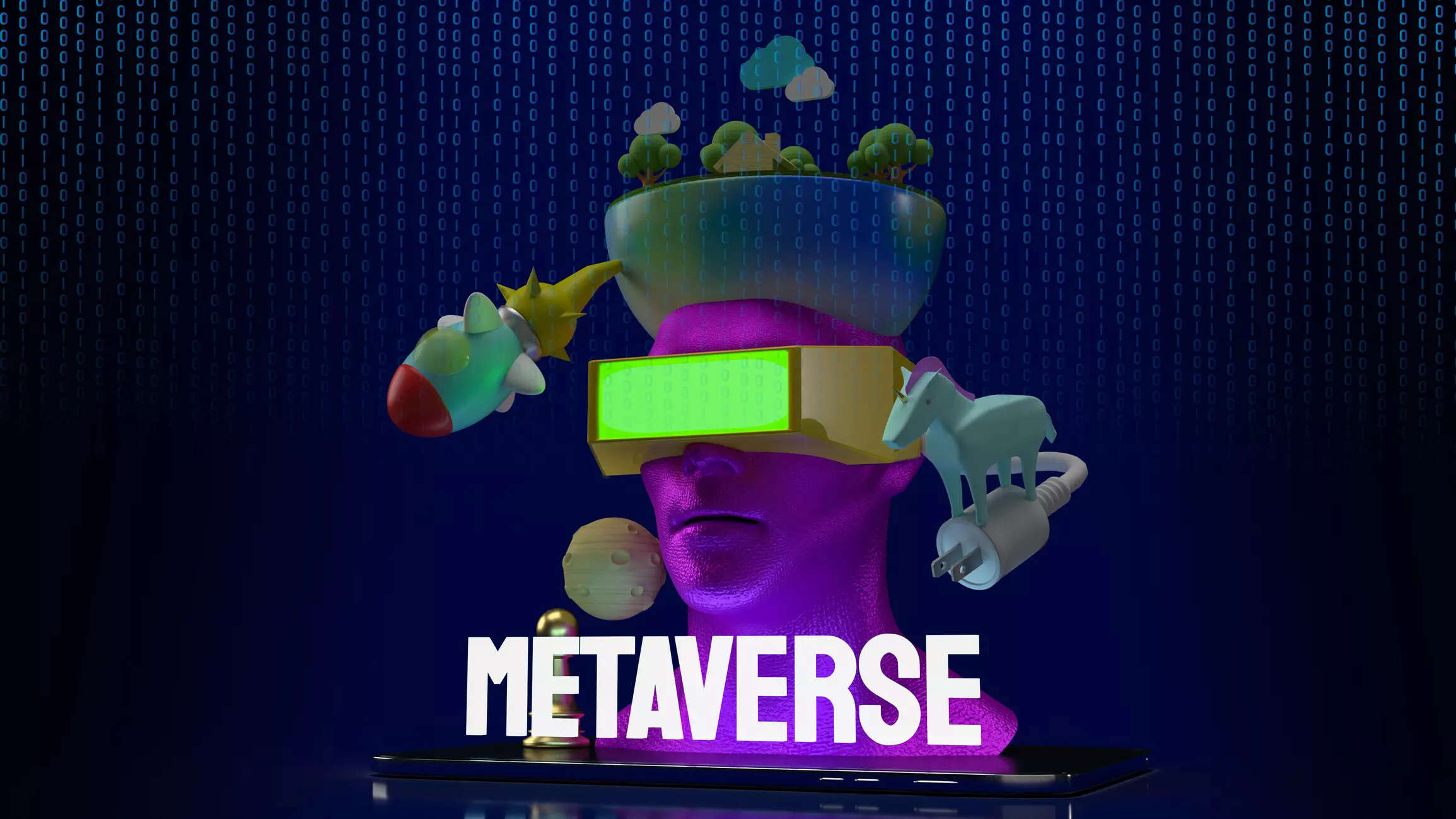Rise in the face of the banking industry through the metaverse in the world, 2022

Rise in the face of the banking industry through the metaverse in the world, 2022
The world is quickly approaching the metaverse era, in which people will live digital lives alongside actual lives in networked, permanent virtual worlds. People will increasingly employ virtual technology in business, recreation, and social networking sectors. Essentially, whatever individuals can do in the real world will have a digital counterpart in the metaverse world with which humans may interact without leaving their homes.
Mark Zuckerberg has lately proven his interest in the digital universe by saying that Facebook (now known as Meta) will transition from a social media firm to a metaverse organization in only five years. The metaverse has undoubtedly benefited from Zuckerberg’s attention.
According to Gartner, by 2026, more than a quarter of people would spend at least one hour per day in the metaverse for business, social networking, leisure, and other reasons. Bloomberg Intelligence also believes that other companies will jump on board shortly, pushing the market to $800 billion by 2024.
It’s reasonable to say that the metaverse has opened up many new prospects in almost every other field. Let’s look at how the metaverse will revolutionize the way banks facilitate, interact, and innovate in the banking business.
Enhancement of the client experience

Banking has become more utilitarian, yet it remains far too emotionally detached. The metaverse, ironically, provides banks with a much-needed method to bring humanity into banking and improve current client connections by meeting them in more meaningful ways. The metaverse offers new channels for reaching out to new audiences, particularly those who are younger and more tech-savvy. One thing is sure: banks and other financial institutions will have to come up with new methods to engage with this NFT-savvy demographic.
You may remember going to a branch with your parents to get their passbooks stamped.
What will be the metaverse’s equivalent in the future generation? Customers may be able to visit virtual branches for high-touch customer service, take a real-time property tour with a mortgage broker, consult with an avatar adviser about retirement planning, attend an investing seminar, or participate in a bank-sponsored community program.
JPMorgan, for example, is the most recent bank to enter the metaverse environment with its Onyx lounge. Furthermore, South Korean bank Kookmin Bank has begun offering one-on-one consultations between client and employee avatars, as well as giving consumers tailored financial information.
In order to investigate this area, banks will need to begin training their employees on the technology as soon as possible. They’ll have to come up with rapid prototypes to help CEOs see the metaverse’s full potential. They’ll have to show how the metaverse links people, places, and things in both the virtual and real worlds, as well as how it may foster a feeling of belonging and collaborative involvement among the leaders. People exist in the metaverse, and they are the metaverse’s sole reason for being.
Establishment of a new market
Digital assets have grown in popularity since their inception in the crypto community, and they are now traded and valued on the open market. To put it another way, real money is already being used to purchase virtual goods.
With the use of the metaverse, banks will be able to virtualize consumer interactions such as cash withdrawals from virtual ATMs, branch stores, and genuine sponsorships for virtual events. If people pushed this to the art of the possible, they could easily walk out of a meeting with their avatar adviser to an ATM, enter their PIN to obtain monies into their virtual wallet, and then walk next door to buy a virtual handbag.
The metaverse’s growing economy offers banks the potential to insure and lend against cryptocurrencies, non-fungible tokens (NFTs), and virtual real estate, a hitherto untapped source of development. Banks must choose what role they will play and how they will use this opportunity to grow their brand.
The launch of new items
Banks are already focusing on NFT-savvy customers, but marketing roles will evolve in the metaverse. Marketing will be done with clients rather than to them in the metaverse. As individuals become collaborators in the metaverse, marketing’s relationship with customers will shift from defining to partnering.
Banks will have to come up with new strategies to establish confidence. It will be vital for all financial institutions to not simply move in and profit when customers select areas throughout the metaverse realms. Instead, they’ll have to put forth a lot of effort to form good bonds. They might seek inspiration from sources outside of their own industry.
Consider Nike’s recent purchase of RTFKT, an NFT design firm, to enhance its brand and truly interact with the community. While the metaverse has tremendous promise for banks, they must proceed with caution since going down the wrong road may severely undermine client confidence.
In a word, there will always be prospects for financial services wherever there are exchanges of goods and services, even in virtual worlds. The ecosystem, on the other hand, has to be further developed, and trust must be built, while the metaverse needs norms and procedures to fulfil banking and financial expectations, as well as an explicit value offer for clients.
A brand new world is taking shape in the metaverse.
Financial services businesses are preparing to offer the necessary support for the metaverse’s transaction development.
With the metaverse, a futuristic technological ecosystem that feeds on the confluence of actual, augmented, and virtual shared places is already a reality. It not only allows users to purchase and sell virtual assets but also propels technologies such as Virtual Reality (VR) and Augmented Reality (AR) to make transactions possible in a completely virtual world.
Consumers in a variety of businesses are increasingly acquiring virtual assets with real money in the form of non-fungible tokens (NFTs).
So, how does the future appear? According to Goldman Sachs, the metaverse will absorb 33% of the digital economy and support a 25% market increase, while Gartner forecasts that by 2026, 25% of individuals would spend at least one hour per day in the metaverse for work, commerce, education, social, and entertainment.
The possibility to monetize virtual land with games, festivals, and other revenue-generating initiatives is driving the surge in metaverse property values, which increased 700 per cent in 2021. Financial services businesses are preparing to offer the necessary financial backing for metaverse transactions.
Banks may guarantee and lend against cryptocurrencies, non-fungible tokens, and virtual real estate in the metaverse. The first to jump on the bandwagon are digital lending start-ups, venture capital, and private equity companies, who have launched their own metaverse platforms or crypto and blockchain-based platforms, offering mortgage loans against virtual real estate, and so on.
Banks are investigating the possibility of offering regular banking services in the 3D environment, with the goal of virtualizing everyday consumer interactions such as cash withdrawals. Banks may discover new clients, onboard them using cryptocurrency wallets, and then provide payment, lending, and custody services.
Financial infrastructure improvements are required for metaverse transactions. The economic backbone for metaverse transactions will be cryptocurrency supported by blockchain, which will be facilitated by smart contracts. Over the last two years, blockchain technology has given birth to a whole new economy that is borderless, safe, quick, and decentralized, thanks to the introduction of Web3 (without intermediaries). The metaverse is founded on the foundations of immersive and decentralized technology at its heart.
Most global banks currently have digital assets, exchange, and custody systems in place, which may be expanded to meet the needs of the virtual world.
Banks may want to consider creating their own virtual world platforms, which would enable new products and even marketplaces while also connecting them to old infrastructure.
Traditional financial services, whether ready or not, will have to adapt to the new free-market internet-native economy’s prospects and problems. To take advantage of the limitless possibilities presented by metaverse, banks and financial institutions must focus on developing technological competency in Blockchain, AR/VR, adopting a disruptive innovation culture, being truly agile with front-to-back integrated teams, and finally, co-creating responsibly by leveraging tie-ups and partnerships rather than building on their own.
The impact of metaverse banking on the banking sector
Banking in the metaverse will need a technology revolution and will usher in a new era of interconnected virtual experiences based on virtual and augmented reality technologies.
The metaverse is the digital society’s next iteration, an inventive method for customers to connect with developing technology. It will be run by digital currencies for improved customer experiences through alliances like the Metaverse Alliance, graphics, and 5G, yet it is still extremely young for the banking sector with no substantial influence. This year, Korean banks were reported to have developed a “virtual town” on a metaverse platform, and other banks are planning to follow suit and open virtual branches.
Every year, customer expectations and needs arise, as do technical capabilities to fulfil and exceed these demands. The incorporation of digital technology into the banking sector has acted as a catalyst for providing clients with a new sort of experience.
Banking in the metaverse: a financial technology transition
The more we talk about the metaverse in the banking business, the better we understand its potential. Banks must evaluate these chances to change everything for the future of the industry, as astonishing as this new transformation may appear. In the metaverse, a bank can provide a “telecommuting” centre for employees and let consumers travel about their own virtual financial town with a virtual branch and economical playground. Through a video conversation, customers entering the virtual chapter may engage with the material and a real-life representative.
Banking in the metaverse will necessitate a technology revolution and will usher in a new era of interconnected virtual experiences based on virtual and augmented reality technologies.
What will customers gain from metaverse banking?
The capacity to conduct funds and transactions in this new world will be critical in making it as immersive and realistic as possible, if not better.
The metaverse provides a much-needed method for banks to reintroduce humanity and experience into banking and strengthen existing client relationships by bringing them together in more meaningful ways.
Customers visiting virtual branches for top-notch customer service, having a home visit with a broker in real-time mortgages, discussing retirement plans with an avatar advisor, attending an investor event, or a bank-sponsored community program are just a few of the new opportunities created by the metaverse for reaching out to new audiences, including a younger, more experienced generation of NFTs.
Article Proofread & published by Gauri Malhotra.







